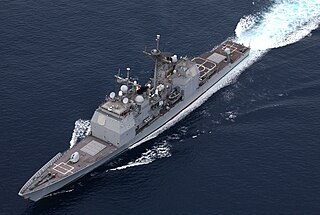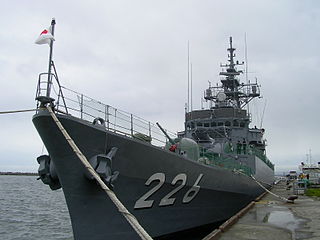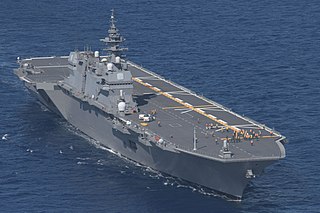
The Aegis Combat System is an American integrated naval weapons system developed by the Missile and Surface Radar Division of RCA, and it is now produced by Lockheed Martin.

The Kongō class of guided-missile destroyers in the Japan Maritime Self-Defense Force are equipped with the Aegis Combat System, and is the first of few ship classes outside the United States to have that capability. Following a decision made in December 2003, Japan is upgrading their Kongo-class destroyers with Aegis Ballistic Missile Defense System. The upgrade involves a series of installations and flight tests to take place from 2007 to 2010. JS Kongo was the first ship to have the BMD upgrade installed.

The Japan Maritime Self-Defense Force, abbreviated JMSDF, also simply known as the Japanese navy, is the maritime warfare branch of the Japan Self-Defense Forces, tasked with the naval defense of Japan. The JMSDF was formed following the dissolution of the Imperial Japanese Navy (IJN) after World War II. The JMSDF has a fleet of 154 ships, 346 aircraft and 50,800 personnel.

The CG(X) program, also known as the Next Generation Cruiser program, was a United States Navy research program to develop a replacement vessel for its 22 Ticonderoga-class cruisers. Original plans were for 18–19 ships, based on the 14,500 ton Zumwalt-class destroyer with additional ballistic missile defense and area air defense for a carrier group. These vessels were to enter service beginning in 2017. The program was ended in 2010 with its mission to be fulfilled by the successor to the Flight III Arleigh Burke–class destroyers.

The Atago class of guided-missile destroyers in the Japan Maritime Self-Defense Force is a modified version of the Kongō class equipped with the Aegis Combat System.

The Takanami-class destroyer is a class of destroyer serving with the Japan Maritime Self-Defense Force (JMSDF). This warship is the slightly modified class of second-generation, general-purpose destroyers of the JMSDF.

The Hatsuyuki-class destroyer is a class of destroyer, serving with the Japan Maritime Self-Defense Force (JMSDF). It was the first class of first generation of general-purpose destroyers of the JMSDF.

The Asagiri-class destroyer is a class of destroyer, serving with the Japan Maritime Self-Defense Force (JMSDF). It was the second class of first-generation general-purpose destroyers of the JMSDF.

The Akizuki-class destroyer was a destroyer class built for the Japan Maritime Self-Defense Force (JMSDF) in the late 1950s. This class was planned to be a flotilla leader with the enhanced command and control capability, so sometimes this class was classified as the "DDC" unofficially.

JS Ishikari (DE-226) was the first destroyer escort with a gas turbine engine and surface-to-surface missiles of the Japanese Maritime Self-Defense Force. She is the successor of the earlier Chikugo class. Entering service in 1981, she remained active until 2007 when she was decommissioned.

The Yūbari-class destroyer escort of the Japanese Maritime Self-Defense Force is the successor of the Ishikari-class destroyer escort. Yubari was named after the experimental light cruiser of the 1920s–1930s, which served in World War II.

The Akizuki class of destroyers of the Japan Maritime Self-Defense Force is intended to escort the Hyūga-class and Izumo-class helicopter destroyers, and safeguard the other Aegis-capable warships such as the Kongō class and Atago class. The destroyer provides defense against surface, airborne and undersea threats. The class was initially designated as "19DD", referring to a date on the Japanese calendar, specifically the 19th fiscal year of the Heisei period (2007).

The Izumo-class destroyers are helicopter destroyers in service with the Japan Maritime Self-Defense Force (JMSDF). The official classification of these ships is DDH, which is accepted by the United States Naval Institute; in contrast, Jane's Fighting Ships describes this official classification, but the classification is simply "helicopter carrier".

FCS-3 is an integrated naval weapons system developed by the Japanese Defense Ministry for the Japan Maritime Self-Defense Force.

The Maya class of guided-missile destroyers in the Japan Maritime Self-Defense Force is a modified version of the Atago class, with an updated Aegis Combat System and electric propulsion system. Maya was commissioned on March 19, 2020. Haguro was commissioned on March 19, 2021.

JS Asahi (DD-119) is the lead ship of the Asahi-class destroyer of the Japanese Maritime Self-Defense Force. Her namesake came from “Morning sun”.

JS Shiranui (DD-120) is the second ship of the Asahi-class destroyer of the Japanese Maritime Self-Defense Force. Her namesake came from the optical phenomenon called Shiranui, or "Phosphorescent Light".

JS Samidare (DD-106) is the sixth Murasame-class destroyer of the Japan Maritime Self-Defense Force (JMSDF). She was commissioned on 21 March 2000.

Aegis system equipped vessels (ASEV) or イージス・システム搭載艦 in Japanese is the designation for a proposed pair of ballistic missile defense (BMD) warships to be operated by the Japanese Maritime Self Defense Force (JMSDF) as dedicated sea-based BMD platforms, serving as an alternative to Japan's now-cancelled land-based Aegis Ashore BMD system.



















